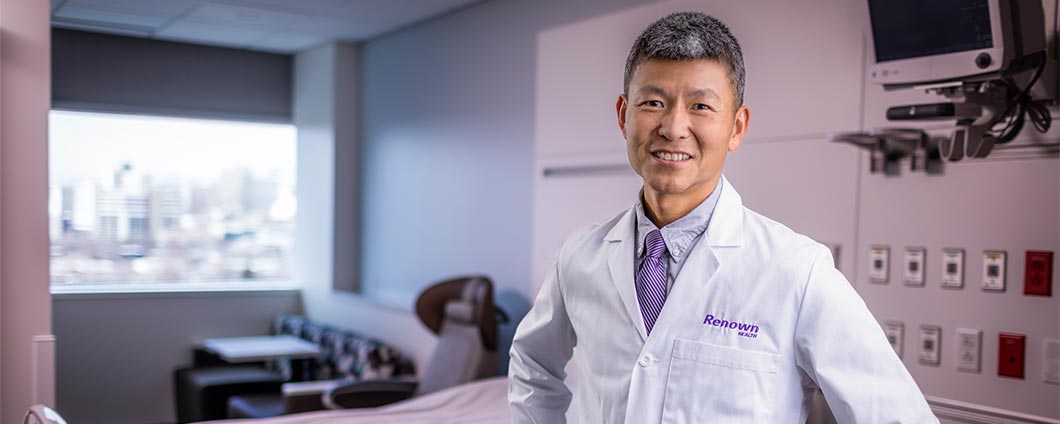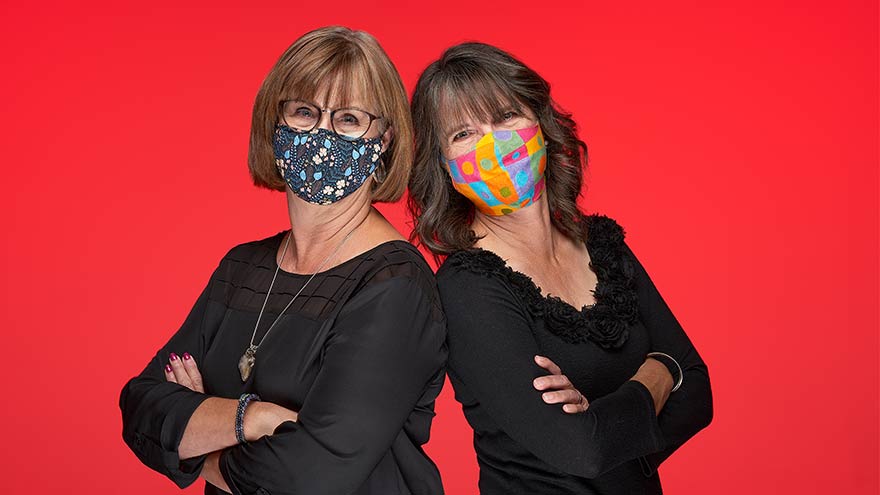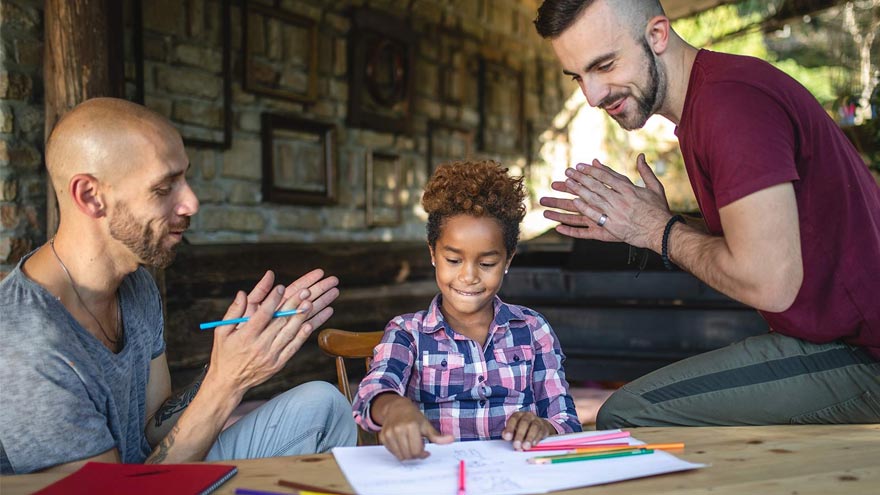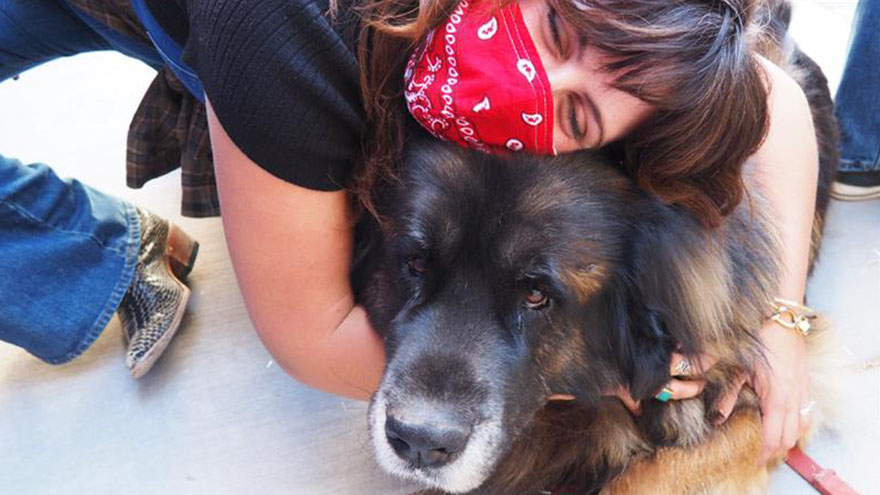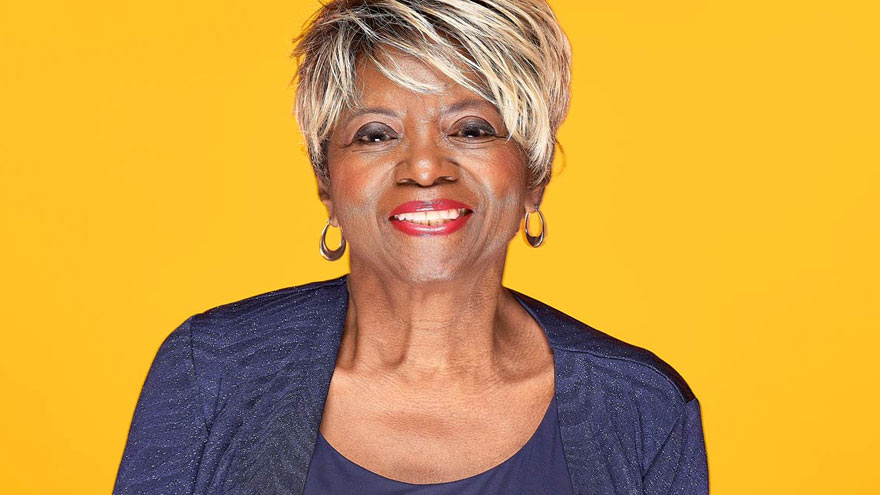Search
Results for 'doctor'
Clear-
Research Trial Opt-Out
Participating in Clinical Research Research studies play a vital role in aiding health providers in preventing, diagnosing, and treating disease. Deciding to participate in a research study is a very personal choice. Once enrolled, researchers may contact you regarding your participation interest. As part of your patient rights, you always have the option to opt-out of communications with researchers and may do so by filling out this simple form.
-
Acute Care Therapy
The Acute Care Rehab Therapists at Renown Regional and South Meadows serve a wide variety of patients and their families with varying acuity levels and diagnoses. The 2 departments (inpatient and outpatient) are made up of around 80 employees, including 14 therapists with over 20+ years of experience and over 700 years of combined experience. What is Acute Care Therapy? The acute care setting is a very fast paced environment with a high volume of therapy orders and fluctuating census. The therapists are considered a consult service with a primary goal of helping with discharge planning and moving patients throughout our system. Depending on location, the therapists generally cover 1-3 floors within the hospital and manage a daily caseload of about 15-20 patients. Our general population ranges from Neonates to Geriatrics. The therapists provide comprehensive diagnostic and therapeutic rehabilitative services (Physical Therapy, Occupational Therapy, and Speech Language Pathology for the treatment of patients with various disorders and related medical conditions. Treatment may include a variety of activities and exercises to maximize a patient’s functional independence. Renown Outpatient Rehab Therapy Services Outpatient Physical, Occupational, and Speech Therapy services to help individuals improve & regain function to allow for higher quality of life and a more active lifestyle. We provide treatment for: Orthopedic Conditions Nerve Injuries Spinal Cord Injuries Sport-Related Injuries Worker’s Compensation Injuries Trauma and Post-Surgical Recovery Vestibular Dysfunction Hand Injuries Speech/Language Difficulties Swallowing Dysfunctions Cognitive Issues Specialty Services Include: Lymphedema Therapy Dry Needling Chronic Pain LSVT Big and LSVT Loud Modified Barium Swallow Studies (MBSS) South Meadows Campus Lite Gait & Solo Step Systems Pre-Driving Assessments and Computer Driving Simulation Wheelchair Evaluations-Basic and Complex Custom Splinting All treatments are one-on-one with a licensed Outpatient Therapist
-
Stroke Program
Stroke is the 5th leading cause of death in the U.S. and the main cause of adult disability. If you or a loved one is experiencing a stroke, you need skilled medical care immediately. The Renown Neurovascular and Stroke Program provides expert emergency stroke care and comprehensive neurovascular care and rehabilitation services. If you suspect that you, or someone around you, is having a stroke, don't hesitate and call 911 immediately.
-
Pandemic Pals and Sterling Silver Club Members
A Friendship Gone Viral When a friendship is strong enough, it can survive just about anything – even a pandemic! Sterling Silver Club members and longtime friends, Marlene and Kim, are living and thriving proof of that. Career & Community Cohorts With successful careers in the Reno area and a common passion for community involvement, it’s no surprise the women knew of each other even before their friendship developed. The first time they actually worked together was in 2001 at TMWA (Truckee Meadows Water Authority), where Marlene’s company was brought on board to steer communications and Kim was heading up the then-new utility’s customer relations department. TMWA was where these colleagues became cohorts who have since become the best of friends. Now retired, Kim’s favorite job these days is being a doting “Noni” to her two granddaughters who live nearby and who she keeps up with by staying active. Kim enjoys practicing yoga and loves to spend time walking and hiking in the great outdoors – with two enthusiastic dogs that are always ready to join her. Marlene is still working and running her nearly 40-year-old public engagement and outreach company, GoodStanding. Her “fun and interesting” projects help to build community engagement for her clients and often focus on water resource management and conservation. The Rotary Club of Reno, known as the “downtown club,” is also an important part of both women’s lives. Marlene was just the third woman to join the historically male organization in 1991 and made it her mission to recruit and sponsor female members – like Kim. Today, women make up nearly half of the membership and Marlene and Kim are both heavily involved in the club and its initiatives, including its scholarship program and community beautification projects along Riverside Drive. A Friendly Q & A To learn more about the friends and maintaining friendships in these socially distanced times, we asked them some questions. What drew you to each other as friends? Kim: Marlene’s honesty, integrity and ethics. Marlene always does what is best for her clients, no matter what. Marlene: Kim and I communicate very well. It’s hard to explain, but sometimes we are both way ahead of our words. How would you describe each other in a single word? Marlene: Focused. Don’t put anything in front of Kim that you don’t want done, and done expertly. Also, helper. She thrives on helping people and working through their problems. Kim: Creative! Marlene came up with many unique ideas to promote and publicize TMWA. And her house the most cozy spaces to sit and visit. Do you have a favorite “That’s so her” moment to share? Kim: Burning Man! Marlene had friends with a camp at Burning Man and she invited me to join them for three days a number of years ago. We rode our bikes, admired the art and did our best to sleep through the techno music that played through the night. It was an amazing time. Marlene: Kim’s involvement in Rotary’s Achievement Beyond Obstacles (a support and scholarship program for deserving local high school students). She has a heart for kids facing challenges, she is a great leader and she loves to help and make a difference. How has COVID-19 affected your friendship, how have things changed and how have things stayed the same? Kim: We don’t see each other in person quite as much. However, Marlene has made sure that many of our girlfriends are able to stay in touch. Marlene: I don’t take for granted we are going to see each other, so we plan it. I am the instigator of walks, socially distanced get-togethers in our green space and Zoom meetings. This new normal has also given me permission to stay home and work. Now, it’s OK to do some gardening or take a walk in the middle of the day. I suppose that’s one pleasant side effect of COVID-19. Why did you become members of the Sterling Silver Club and why would you encourage others to join? Kim: So many friends and family members had nothing but good things to say about Renown that I decided to switch providers. I also really liked what Renown was doing with the Healthy Nevada Project. So, when I saw the Sterling Silver Club, it seemed to me to be just another extension of all the good things Renown has to offer! Marlene: This Club sounded interesting because it would allow me to focus more on my health with like-minded people in my age group. And, I’m with Kim, Healthy Nevada Project is very intriguing for how it could potentially improve health care for all of us. What is the secret to a lasting friendship? Kim: Have patience. Don’t take things personally. Be flexible. And just enjoy one another’s company. Marlene: Respect and grace, equally. We are not perfect and we are all different. So give your friends respect always, grace when they flub up and support when they need help. Thanks to Kim and Marlene for being such generous collaborators and ambassadors of the Sterling Silver Club. Friend Fun Fact: Kim helped Marlene find her new house a few years ago – and more recently, a new dog! Marlene and “Levi” have been inseparable ever since.
Read More About Pandemic Pals and Sterling Silver Club Members
-
A Day in the Life of a Child Life Specialist
March is Child Life Month, meaning this is the perfect time to ask: What exactly does a Child Life Specialist do? To find out, we “virtually” tagged along with one for a day. This is what a typical day looks like in this important role. For Child Life Specialist Brittany Best, play is a natural part of her work day. She approaches her role with a keen understanding of how the seemingly small tasks she performs every day — comforting children prior to a procedure, writing thank-you notes to donors, training interns — positively impact the lives of the children she serves and their families. So what does it take to work in Renown’s Child Life Program? Best shares some of the highlights from a “typical” shift. A Child Life Specialist’s Day 7:30 a.m. Clock in, put my belongings in my office, and print the patient census information. This helps me to get a sense of the day ahead, as I’m covering three areas today. 8-9 a.m. I look over the census sheets for all three areas and check in with the nurses in each area and then try to prioritize my day. 9:00 a.m. I attend Interdisciplinary Rounds for the Pediatric Intensive Care Unit, where the most critically ill or injured children are treated. Additionally, Interdisciplinary Rounds enable several key members of a patient’s care team to come together and offer expertise in patient care. 10:00 a.m. I come up to the specialty clinic/infusion center to check on the patients that have arrived already and see how things have been going since I had last seen them. We see patients frequently up here, as they are receiving treatment for cancer or other disease processes. 10:55 a.m. I’m notified by an RN that a patient needs an IV started, so I go meet with the patient and their family. I meet with a 6-year-old and mother to explain what an IV is and why it is needed. We go through an IV prep kit, looking at all the different items the nurse will use including cold stinky soap, a tight rubber band and also a flexible straw. I also teach this patient a breathing exercise to help them relax during the procedure with a simple exercise known as “smell flowers, blow out candles.” I demonstrate how to take a deep breath in through the nose — like smelling flowers — then how to blow that breath out — like blowing out birthday candles. 11:10 a.m. I walk with the patient and mom to the procedure room on the Children’s Patient Floor for an IV procedure. The Vecta distraction station is set up and running with its bright lights and water tube that bubbles with plastic fish swimming. The parent holds the patient in their lap, and with the distraction and medical preparation, we are successful! I give the patient a toy and provide emotional support to both the young patient and his mom. It’s easy to forget that these procedures can be stressful for the parents as well. 11:30 a.m. I finish rounding with staff to catch up on patients. In addition, I introduce myself to patients and put my contact number on the board in each room so the families know how to get a hold of me should they need anything. With support from volunteers, we distribute movies, games, and “All About Me” forms to patients and their families. These forms help us get to know our patients with things like their favorite foods and televisions shows. 12:45 p.m. I help with a lab draw in Children’s Specialty Care. A 3-year-old patient is very anxious about the “shot,” so I meet with the patient and parents to discuss coping techniques. The patient holds the Buzzy Bee and does well during the lab draw. The mom is relieved, and the patient is excited for a toy. The Buzzy Bee actually helps block the transmission of sharp pain on contact through icy numbing and also tingly vibration. 1 p.m. Joan, an artist with our Healing Arts Program, arrives on the Children’s Patient Floor to perform art therapy with patients. She helps two young patients who are interested in watercolor paintings. 1:15 p.m. Time for lunch and also a trip to Starbucks. 1:45 p.m. I finishing rounding and introducing myself and our services to the patients I have not met yet. 3 p.m. At this time, I meet with the parents of a newly diagnosed diabetic patient who is in intensive care. A new chronic diagnosis is always difficult, so I am there to provide emotional support. It’s instances like this that remind me every day why I love the work I do. 3:30 p.m. I meet with a new volunteer, discuss their role and also give the new volunteer a tour of the units. We are very thankful for all our volunteers on the floor, as their contributions help us provide a variety of basic services to a larger number of children. This also allows the Child Life Specialist to devote time to children who require more intense or specialized service. 4-5 p.m. I finish charting on patients and help two newly admitted families before I start to wrap up for the day. This evening we have a volunteer covering the times during shift change, which is helpful as it makes for a smooth transition for families during the meal time and change of shift. During this time, I write a note for this volunteer indicating the patients I want her to focus on. 5-5:30 p.m. Check in with critical patients and families before leaving for the day. All-in-all, it was a good day.
Read More About A Day in the Life of a Child Life Specialist
-
SOGI – The Most Important Terms to Know
SOGI stands for sexual orientation and gender identity. Being a SOGI-inclusive medical facility means regardless of our differences, we treat others with dignity and respect. Sean Savoy, Renown Health Manager of Spiritual Care, explains SOGI terms and their importance in a healthcare setting below. SOGI History Although the UN passed a historic resolution on SOGI in 2016, it is still a relatively new term for some. Above all, an inclusive environment where every patient feels safe and valued, improves the quality of care in our community. In reality, defining gender and sexuality can be confusing. However, the terms we use to define gender and sexuality are an important influence on how we relate to each other. Generally, "sex" refers to the biological differences between males and females. Still the term “sex” doesn’t fully capture the complex biological, anatomical and chromosomal variations that can occur. Accordingly, having only two (binary) options – biological male or biological female – might not describe what’s going on inside a person’s body. In essence, assigned sex (also called "biological sex) is given at birth based on medical factors. These include your hormones, chromosomes and genitals. Most people are assigned male or female, and this is what’s put on their birth certificate. When someone’s sexual and reproductive anatomy isn’t clearly female or male, that person may be described as “intersex.” However, a person’s biological or assigned sex may be different from a person’s actual or perceived gender identity or expression. The word “gender,” therefore, is more difficult to define. It could refer to the gender or sex role society determines is acceptable, desirable or appropriate based on a person’s perceived sex. Likewise, it could refer to an individual’s own gender identity or preferred gender expression. What is Gender Identity? To summarize, gender identity is one's innermost concept of self as male, female, a blend of both or neither. To clarify - how individuals perceive themselves and what they call themselves. Of course sometimes a person's genetically assigned sex does not line up with their gender identity. These individuals might refer to themselves as transgender, non-binary, or gender-nonconforming, for example. Another key point is the process of gender transition. This specifically refers to more closely aligning your internal knowledge of gender with your outward appearance. According to the American Psychiatric Association's Diagnostic and Statistical Manual of Mental Disorders (DSM), the term – which replaces Gender Identity Disorder – "is intended to better capture the experiences of affected children, adolescents, and adults." What is Sexual Orientation? Sexual orientation is an internal or enduring emotional, romantic or sexual attraction to other people. For example, you could be heterosexual (straight), gay, lesbian, bisexual or even pansexual. SOGI Terms to Know Below are some common SOGI terms according to the National LGBT Health Education Center and the Human Rights Campaign. The following list is not meant to represent every term (or definition) used by the LGBTQ+ community. LGBTQ+ Stands for lesbian, gay, bisexual, transgender and queer (or questioning). The plus encompasses other identities that fall under the queer umbrella with one common theme: they are not strictly straight or cisgender. Queer An umbrella term used by some to describe people who think of their sexual orientation or gender identity as outside of societal norms. Some people view the term “queer” as more fluid and inclusive than traditional SOGI identities. Due to its history as a derogatory term, the term is not always embraced or used by all members of the LGBTQ+ community. Sexual Orientation Terms Asexual (adj.) – Describes a person who experiences little or no sexual attraction to others. Asexuality is not the same as celibacy. Bisexual (adj.) – A sexual orientation that describes a person who is emotionally and sexually attracted to people of their own gender and people of other genders. Gay (adj.) – A sexual orientation that describes a person who is emotionally and sexually attracted to people of their own gender. It can be used regardless of gender identity, but is more commonly used to describe men attracted to other men. Heterosexual or Straight (adj.) – A sexual orientation that describes a person whose sexual or emotional attractions and behaviors focus exclusively or mainly on members of the opposite sex or gender identity. Lesbian (adj., noun) – A sexual orientation that describes a woman who is emotionally and sexually attracted to other women. Pansexual or Omnisexual (adj.) – A sexual orientation that describes a person who is sexually and emotionally attracted to people of any sex or gender identity. Pansexual people may refer to themselves as gender-blind, asserting that gender and sex are insignificant or irrelevant in determining whether they will be sexually attracted to others. Gender Identity Terms Bigender or Binary (adj.) – Describes a person whose gender identity is a combination of two genders. Cisgender (adj.) – A person whose gender identity aligns with the assigned sex at birth or biological sex. Gender non-conforming (adj.) – Describes a gender expression that differs from a given society’s norms for males and females. Gender transition (noun) - The process by which some people strive to more closely align their internal knowledge of gender with its outward appearance. Some people socially transition, whereby they might begin dressing, using names and pronouns and/or be socially recognized as another gender. Others undergo physical transitions in which they modify their bodies through medical interventions. Intersex (adj.) - A variation in sex characteristics including chromosomes, gonads, or genitals that do not allow an individual to be distinctly identified as male or female. Non-binary Alternate terms are gender queer and gender non-conforming. Transgender (adj.) – Describes a person whose gender identity and assigned sex at birth do not correspond. Also used as an umbrella term to include gender identities outside of male and female. Sometimes abbreviated as trans. SOGI Awareness Again, not all people use the above terms in the same way, so respect and sensitivity are key. And the healthcare setting is an especially vulnerable one. Maintaining the dignity and humanity of every individual during a medical interaction is essential. The U.S. Department of Health and Human Services requires all Electronic Health Record (EHR) systems be able to collect SOGI information from patients. This promotes better understanding of health treatment outcome disparities in order to reduce them. Renown Health’s mission is to make a genuine difference in the health and well-being of the people and communities we serve.
-
Getting to Know Renown's Canine Companions
A slobbery kiss, a wagging tail, a judgement-free smile. There are few things better than the love and attention of a canine companion. At Renown Health, we have a loyal and playful group of pet therapy teams. This volunteer program uses animal-assisted interactions (AAI) and animal-assisted therapy (AAT) to provide comfort, reduce boredom, increase social interactions, improve mood, boost general well-being and – perhaps most importantly – bring smiles to our patients’ faces. Benefits of AAT & AAI: Lowers blood pressure and heart rate by relieving anxiety Helps in pain management Eases feelings of depression, loneliness, boredom and isolation Stimulates communication Encourages physical activity For more information about the program, a complete list of our teams or to get involved, click here. Meet Keno and Linda Linda, Keno’s human, has volunteered as one-half of a therapy dog team for more than 14 years. Keno is her third Newfoundland, and he is a sweet and cuddly 2-year-old pup, who, according to Linds, thinks is a lap dog. “My mother was in assisted living for almost 10 years, and I saw what an impact a therapy dog can have,” Linda said. When she moved to Reno from Portland six years ago, she immediately contacted Renown. A Memory the Stands Out: A patient in the ICU was not responsive because of oxygen deprivation due to almost drowning. Linda and Keno went into the patient’s room at his physical therapist’s request, and the therapist asked the patient to reach out and pet the dog. After the third request, he moved his hand toward the dog, and his mother burst into tears. It was the first time the patient had moved since his accident. Linda and Keno went back several days in a row, and soon the patient was talking, sitting up and eating on his own. Meet Madi and Clark Madi, Clark’s human, is an employee at Renown, and Clark made it a family affair by joining the team in Sept. 2021. Clark is a unique pup with an amazing demeanor who adores everyone as much as they adore him. He is a hardworking Goldendoodle who loves to be a goofball at home when he’s off the clock. Why They Became a Therapy Dog Team: Madi was inspired to get Clark trained as a therapy dog because, as an employee at Renown, she was always so happy to see dogs walking around, and she knew that I wanted to provide that same relief to others. Her favorite thing about being a Renown volunteer is the joy it spreads to those working and the patients they are caring for. Meet Richard and Raven Raven is a four old Belgian Malinois who has been working as a therapy dog for two and a half years. She is calm, friendly and loves having her tummy rubbed. “The therapy dog teams are just one little part of Fighting the Good Fight,” Raven’s human Richard said. A Memory that Stands Out: Raven and Richard were assigned to the Sierra oncology ward one shift and visited a woman who had a picture of her dog displayed next to her bed. Raven immediately went to the bedside and the patient started petting her. As she spent more time petting Raven, Richard could see the stress disappearing from her face. He later learned that it was the patient’s first chemotherapy infusion, and Raven gave her the peace and the strength she needed to face the chemotherapy head-on. Meet Savannah and Hallie Hallie and Savannah’s journey as a therapy dog team began in 2017 at the Morgan Stanley Children’s Hospital in New York and has also taken them to San Francisco General Hospital and Stanford Hospital. The duo moved to Reno in 2020 and immediately joined the Renown Pet Therapy Program. A friend, energetic and cuddly American Cocker Spaniel, Hallie especially loves spending time with the young children at the hospital. A Memory That Stands Out: Savannah remembers one visit to a patient in the Children’s Emergency Room who was struggling with suicidal thoughts. Having struggled with mental health herself, Savannah felt a deep connection to the patient and a need to help. She recalls placing Hallie on the patient’s bed a seeing a “very small hint of a smile.” Savannah later learned that the Renown nurses hadn’t seen the patient smile in days. It was that moment that made Savannah realize what a profound impact Hallie can have on patients. Meet Chivas and Donna Chivas was a McNab/Border Collie mix who volunteered at Renown with her human Donna for two years. With help from Donna, Chivas was a master at reading situations in the hospital and reacting accordingly. For example, if a patient was afraid of dogs, she would sit with her back to the person so she didn’t come off as threatening. Contrarily, she would lie down on the floor when playing with young children to let them pet her on their level. Why They Became a Pet Therapy Team: This dynamic duo started out as a member of a local pet therapy group. During the height of the COVID-19 shutdown, they participated in outdoor pet therapy parades for various hospitals in the area. Donna and Chivas met Renown Volunteer Coordinator Wendy Peuket at one of the parades and she inspired Donna to pursue becoming a registered therapy dog team for Renown's Therapy Dog Program. Chivas sadly passed away unexpectedly in early December 2021, and the world is a whole lot dimmer place without Chivas’ light shining brightly.
-
What Foods to Eat and What to Avoid When Pregnant
Eating a well-balanced and nutritious diet when pregnant is one of the more essential things you can do for your baby and yourself. The basic principles of what to eat when pregnant are quite similar to how we should be eating all the time. This includes focusing on fruits, vegetables, whole grains, lean protein and healthy fats. Of course, there are a few areas that you should pay close attention to when you’re pregnant and a few foods you should avoid. We consulted Renown Health’s Caitlin Bus, RD, LD, CDE to learn more about pregnancy nutrition. Foods to Eat Regularly: Veggies Vegetables of all kinds -- and in all forms -- are beneficial for you and your baby during pregnancy. Veggies ensure your body is getting the fiber, vitamins and minerals it needs. However, fresh or frozen veggies are considered best, but if you choose to eat canned veggies, make sure you choose a low sodium product. The more greens, the better! If you have an aversion to vegetables, especially in the first trimester, try sneaking them into smoothies. Healthy Proteins Protein-rich foods support your baby's growth while giving your body the nutrients to build and repair tissues, including your muscles, hair, skin and nails. Although protein requirements vary from person to person, a pregnant woman needs additional protein for her baby's growth, especially in the second and third trimesters. Regularly eating high protein foods -- like fish, chicken, turkey, eggs, peanut butter, nuts and beans –– promotes your baby's healthy brain and heart development. Grains Food like brown rice, quinoa, whole-wheat pasta and oatmeal are great to eat while pregnant. They are rich in fiber, iron, B vitamins and folic acid, which are all beneficial to physical development. Grains also help alleviate constipation and hemorrhoids. Fruits Fruit can help satisfy any sugar cravings you have when pregnant while also supplying your baby with nutrients – it's a win-win. Some people advise against fruit consumption while pregnant, but this is a myth. Like with all foods, moderation is key. Fruit can be high in sugar, so it is important to be aware of your intake. Also, make sure you are mindful of your preparation – thoroughly rinse produce under running water for 30 seconds to help avoid foodborne illness. Pasteurized Dairy Dairy products like milk, cheese and yogurt can be great sources of protein and calcium needed for the healthy development of a baby's bones, teeth and muscles. These foods also help with ensuring healthy heart function and nerve transmission. When buying these products, make sure to choose pasteurized products to avoid exposing your body to germs and bacteria. The American College of Obstetrics and Gynecology recommends 1,000mg of calcium per day for pregnant and lactating women. This equates to 4 servings of dairy or calcium-rich foods such as leafy greens, broccoli, tofu, almonds or dried figs. DHA Omega-3 Fats Omega-3s like DHA help support the health of a baby's brain and parts of their eyes. Women who are pregnant or breastfeeding should eat at least 8 ounces and up to 12 ounces of seafood each week. Ideally, food sources that offer DHA omega-3 and that are lower in mercury should be emphasized in your diet, including fish like salmon, sardines and anchovies. If you do not eat fish or omega-3 fortified foods, a DHA omega-3 supplement is recommended. Choline Did you know that 92% of pregnant women fail to meet the daily choline recommendation? Choline is crucial for an infant's brain and central nervous system development. One egg supplies 33% of the recommended daily intake. Although choline is often absent or low in prenatal vitamins, the best food sources include eggs, meats, fish, dairy, navy beans, Brussels sprouts, broccoli and spinach. Iron and Folic Acid Iron is the most common nutrient deficiency during pregnancy. Foods with high and moderate amounts of iron include red meat, chicken, fish, fortified cereals, spinach and beans. Folic acid is used to make the extra blood your body needs during pregnancy. Consuming adequate folic acid early in pregnancy reduces the risk of birth defects that affect the spinal cord. It is recommended to consume 400 micrograms (mcg) per day for pregnant women. This amount is included in your prenatal vitamins. Water Staying hydrated is one of the best things you can do for yourself and your baby when pregnant. In addition to just being good for you, hydration alleviates morning sickness and nausea, while dehydration can lead to contractions and even pre-term labor. Aim for 10 cups of fluids per day, on top of the water naturally occurring in foods. Foods to Avoid: Raw Fish and Fish with High Mercury Content Sorry sushi fans, according to the Center for Disease Control and Prevention, pregnant women are 10 times more likely to get infected by Listeria, a bacteria found in raw or undercooked fish. Also, avoid fish often found to be high in mercury, including swordfish, king mackerel, tuna and marlin. Processed or Raw Meat Similar to eating raw fish, eating undercooked or raw meat increases your risk of infection while pregnant. Hot dogs and lunch meats should also be avoided, unless they have been reheated to be steaming hot (for example, in a microwave). Alcohol Drinking alcohol when pregnant can impact your baby’s brain development and increases your risk of premature birth, low birth weight or miscarriage. Just don’t do it! Minimize Caffeine High caffeine intake during pregnancy can restrict your baby’s growth; therefore, it is recommended that pregnant people limit their caffeine intake to less than 200 mg per day – that’s roughly two cups (16 fl oz) of coffee per day. Runny Eggs Eating raw or runny eggs when pregnant increases your risk of Salmonella, which can cause fever, nausea, vomiting, stomach cramps and diarrhea. Always make sure your eggs are cooked through or use pasteurized eggs.
Read More About What Foods to Eat and What to Avoid When Pregnant
-
Simply Spectacular Sterling Silver Member Rhogenia
Whether watching a 4th of July celebration from her father’s boat on the Saint Johns River or sneaking a peek at a post-game display over Gator Bowl Stadium from her parents’ bedroom window, the fondest childhood memories of Sterling Silver Club featured member are of fireworks. “I love watching fireworks,” says Rhogenia. “And I get just as excited by them now as I did then.” Well, fireworks are certainly a fitting introduction to this Sterling Silver Club member who shines with a spectacular collection of accomplishments, adventures and interests. A Passion for Teaching Rhogenia remembers herself as a happy, carefree child “who read all the time” while growing up in Jacksonville, Florida with her younger sister, Rosemary, and her father and mother, who was a public school teacher. It’s easy to see how this natural enthusiasm for reading (and learning), along with her mother’s influence, would spark Rhogenia’s calling – and passion – for teaching. After earning her bachelor’s degree in education, Rhogenia spent the first 2 years of her career as a kindergarten teacher in a “one traffic light” town in her home state. She then moved to Oakland, California where she taught kindergarten and first grade classes at various schools for 4 years. The Biggest Little City in the World came next, and her stay there would last much longer. In Reno, Rhogenia added a master’s degree to her credits and found a home for her teaching career at Grace Warner Elementary School – where she taught first and second grade for 20 years! During that time, she also took on the additional role of adjunct professor, teaching graduate students for the University of Phoenix, College of Education. “A great teacher never stops learning,” explains Rhogenia. “I believe the art of teaching is the act of facilitating discovery, for students and also for myself.” In recognition of her efforts, Rhogenia received the Reno Gazette Journal’s Best of Education Award, the Washoe County Teachers Association Distinguished Performance Award, and was also awarded a grant from Learn and Serve America to help her support student programs that gave back to the community. Rhogenia’s favorite quote: “One hundred years from now it will not matter what my bank account was, the sort of house I lived in, or the kind of car I drove. But the world may be a little better, because I was important in the life of a child.” – Adapted from an essay by Forest Witcraft Commissions, Councils & Space Camp Life outside the classroom also kept Rhogenia busy – and inspired – throughout her career. In 1998, she was selected to participate in an educator externship, and in 1999, was chosen to be a teacher consultant to the Alliance Summer Geography Institute. These opportunities allowed Rhogenia to return to her students with exciting lessons to share about different types of industries and the importance of geography, respectively. In 2002, the governor appointed her commissioner for the state of Nevada’s Commission on Professional Standards in Education. And Rhogenia followed that up with an appointment to the National Council for Accreditation of Teacher Education in 2004. She also got to travel. Rhogenia was one of two teachers from Nevada chosen to participate in the Japan Fulbright Memorial Fund Teacher program on its 50th anniversary. Originally established in 1946 to foster mutual understanding between the U.S. and Japan, the trip allowed Rhogenia to represent her state, her country and her race to Japanese dignitaries, business people and students alike. For over three weeks, she toured schools, universities, factories, temples, art galleries and museums, and stayed in the home of a Japanese family for a few days – which she calls the highlight of her trip. Oh, and then there was the time she went to space camp! The Nevada Teacher in Space Program sent Rhogenia to join teachers from across the county at the out-of-this-world camp in Huntsville, Alabama. On “Team Endeavor,” she learned what it would be like to deliver payloads and perform experiments at the International Space Station, and took a seat in flight simulators and an antigravity chair. The goal of the program was to inspire teachers to help their students learn about the infinite possibilities of math and science. Time for What Matters These days, Rhogenia enjoys spending time on the things that matter most to her. Personally, that means diving into hobbies like genealogy, music, reading, writing, cooking and the occasional card or board game. She also continues to learn and broaden herself through Osher Life Long Institute (OLLI) classes and Retired Living Truth Series seminars. But her greatest joy comes from spending time with family – four generations of her own family, her church family, retired teachers from Warner Elementary and the many acquaintances and friends she’s come to know over the years. Other things worthy of Rhogenia’s time: Giving back to the community, rainbows, sunsets and sometimes, just watching the clouds roll by. Membership & Senior-ship What does Rhogenia think about being a Sterling Silver Club member and a senior? She told us. “Before COVID, it was the face-to-face club events that I liked most,” recalls Rhogenia. “At the Silver Stars Gala, I had such a wonderful time chatting with old and new friends… the fashions, decorations and the food were delightful.” Over the past year, she also found things to love about the club’s virtual events and regularly attends lectures, cooking and yoga classes and weekly meditation sessions – from her home! It Starts with Hello offers some of her favorite club events. “It reminds me of the television show, Cheers, where everybody knows your name!” she grins. “We meet at noon on Tuesdays and Thursdays. There are a variety of topics and guest speakers, and with the virtual events, I feel like the presenters are talking directly to me… I have the best seat in the house.” As far as being a senior goes, Rhogenia is living her best life and has some advice to help others do the same. “As a senior, I have the time to explore and take advantage of the many opportunities available out there,” she says. “I live life in the present and to the fullest. I make the most of each day because tomorrow, it will be the past.” Rhogenia feels that the biggest challenges for seniors today are health and isolation, and wants people to know there’s help if they need it. “Sometimes we need a little help to make everyday activities a little easier, or just need a person to talk with,” she explains. “My advice is never be too proud to ask for help with anything! Most people are glad to help or guide you to someone who will.” “Lastly, to seniors, I would like to say this: Love yourself and make peace with who you are and where you are at this moment in time,” Rhogenia continues. “And give yourself a big hug!” The Sterling Silver Club thanks Rhogenia for dazzling us with her story, her friendship and her collaboration – and we send her and all of our members a “BIG hug.”
Read More About Simply Spectacular Sterling Silver Member Rhogenia

